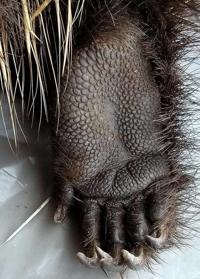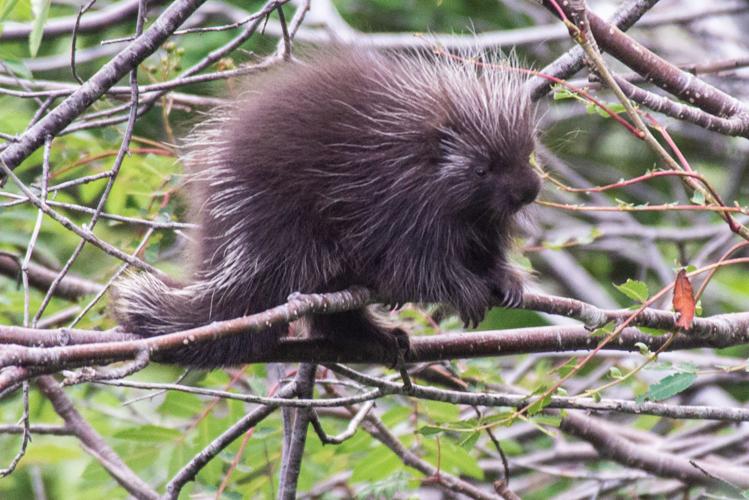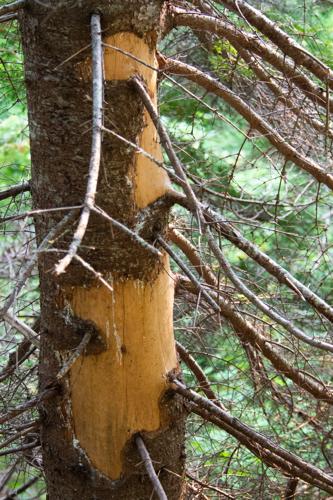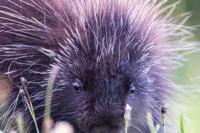When I was a college student, I had a professor who gave a lecture titled “The Unloved Ones.” His slide show was populated with photos of animals like skunks, tarantulas, snakes and others people typically avoid. I do not recall if porcupines were featured, but they sure do qualify as unloved by many.
The level of “unlove” you feel for porcupines probably depends on two factors – how common they are where you live and whether you own a dog or not. Porcupines are most famous for the quills that cover the majority of their bodies. The quills are designed purely for defense, thank goodness, and therefore humans can easily avoid them by not causing a porcupine to have to defend itself. But dogs are more curious and often intrude on the personal space of a porcupine they find. Well, at least the first porcupine they find. Some dogs are quick to learn to avoid these spiky rodents, while others need multiple lessons before they change their behavior.
Quills are an amazing adaptation and since DNA studies show that the porcupines in the Western Hemisphere are not closely related to the porcupines of Africa and Asia, it is an adaptation that has evolved twice. Literally, quills are modified hollow hairs. When viewed under very high magnification, the tips of the quills show barbs pointing backwards. This means that quills have a much easier time going in than coming out. If not removed, a quill can simply work its way deeper into an animal. When I lived in Utah, an emaciated mountain lion was found very close to our city limits. A necropsy revealed a porcupine quill had pierced his heart, making it harder for him to function and capture prey. The wildlife veterinarian estimated it took months for the quill to migrate that deep.
Perhaps it is observations of quills far into the muscles of animals that has led to the myth that porcupines can shoot their quills. They cannot. If your dog comes home with a face-full of porcupine quills, it means she has been in direct physical contact with the porcupine. They will swing their tails wildly as well as raise and lower their quills the way other mammals do with their hair (the technical term for this is piloerection), but they cannot project them.
It seems a contradiction that the quills can stay firmly attached to the porcupine’s skin, yet so easily come off in the flesh of an attacker or inquisitive investigator.
Uldis Roze, a researcher in the Catskill Mountains, solved this puzzle by discovering that porcupines have a unique system of attachment. When a quill is pushed down, as it would be in a predator attack, the attachment breaks and the quill is easily detached from the porcupine’s skin. But without that initial downward motion, the attachment is strong, quills remain in place and porcupines do not suffer from male-pattern baldness.
I had an opportunity to observe this firsthand while on a trail run at the Cutler Boy Scout Camp in South Bristol. I remember it was a warm and sunny spring day, full of bird song, marred only by my out-of-shape gasps for breath as I trudged up yet another incline. I had slowed almost to a walk when I heard some scuffling in the leaves ahead and spied a porcupine. No doubt, it had already seen and heard me — its quills raised in defense. The porcupine made no attempt to run (although, considering my state, that would have worked well for him), instead opting to let his defensive perimeter keep him safe. The longest quills were on its back and, remembering Roze’s discovery, I gently grabbed one and pulled. And pulled. It would not come loose. I then pushed down and pulled and the quill came out easily. I had broken the connection between the quill and the skin, just as a predator would have.
A rare sighting
That is my only firsthand encounter with a porcupine in the Finger Lakes region. They are not common here, although they were at one time. Historically, our region was thought to be about 95 percent forested. By 1900, only about 10 percent of our area remained in forest. With the loss of the forest came a drastic reduction in the animals that require that habitat to live, including the porcupine. Today, the region is about 75 percent forest and many of the forest species have returned in great numbers. Black bears and fisher are two mammals that are again common in the Finger Lakes. So why hasn’t the porcupine population rebounded as swiftly?
I believe the answer is a combination of the porcupine’s natural history and human attitudes. Porcupines are slow animals. That is no surprise. Quills rather than super speed serve as protection. So by their nature it will take them longer to disperse. In addition, that slow speed means they are more prone to being hit by cars, making range expansion more difficult.
But I think intentional human interference is a huge factor in the slow return of porcupines. In New York, porcupines are classified as “unprotected wildlife” under the law. That means that they can be killed at any time in just about any manner. In addition to the aforementioned negative interactions with dogs, porcupines can be destructive. Just about anything made of wood can be fair game for a porcupine to gnaw on, but they are particularly attracted to salty objects since salt helps them digest nitrogen, a main ingredient in protein. Much of their diet is low in nitrogen so they have to make the most of each meal. Natural and artificial salt licks are huge attractants to porcupines but so are ax handles and outhouse seats because they accumulate human sweat and therefore salt. Plywood is made with an adhesive that has a bit of sodium in it and porcupines go for that, too.
Even when porcupines stick to a totally natural diet they can be a nuisance. In the summer months they eat leaves, but in the winter they must rely on lower quality foods such as pine needles and tree bark. Stripping the bark from a tree will damage or kill it. Earlier in this column, I mentioned that one’s views on porcupines is probably dependent on how common they are in your neck of the woods. My father owns a hunting camp in Steuben County and I can find the telltale signs of porcupines in the forest there. Porcupines exist there in small numbers, making it easier to tolerate their presence. In areas with high populations of porcupines, they can be a problem.
But we are lucky. Porcupine numbers at Dad’s camp are low. In addition, we are not foresters or Christmas tree farmers. We have no dog and our outhouse door securely locks, so we can afford to have a generous view of porcupines rather than a combative one.
Van Niel, an environmental conservation professor at Finger Lakes Community College, lives in Seneca Falls and enjoys exploring wildlife around the world as well as in his own backyard. If you have comments, Van Niel can be contacted at bears@flcc.edu.










































































